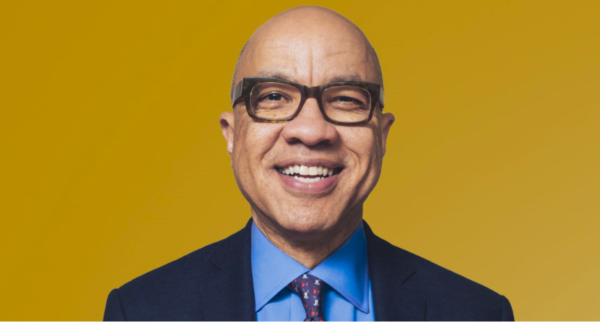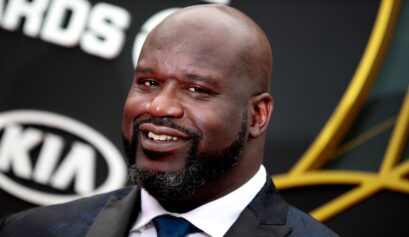By Karen Toulon
Darren Walker, 62, disrupted his Wall Street life more than 25 years ago when he left what is now UBS Group AG to volunteer at a school and eventually pursue a career in community development and philanthropy. Since 2013 he’s been at the pinnacle of the philanthropic world as president of the Ford Foundation, created by the family of automaker Henry Ford during the Great Depression to advance human welfare.

The past year and a half has featured a challenging set of social disruptions: the Covid-19 pandemic and the resulting economic damage, a racial reckoning in the U.S., and climate-related destruction. Walker has tackled these in inventive ways, including issuing $1 billion of 30-year and 50-year “social bonds” that enabled the foundation to boost its giving to meet needs created by the pandemic. Since then, rising markets have lifted the foundation’s endowment to more than $17 billion. Walker spoke with Bloomberg Markets in July. (In late September, one of the foundation’s grant recipients, startup Ozy Media, was accused of misleading potential investors and partners. Matthew Creegan, a Ford Foundation spokesperson, said the foundation hasn’t given money to Ozy since it provided $1.95 million to fund programming in 2016 and 2017. Walker declined to comment.) This interview has been edited for length and clarity.
KAREN TOULON: Explain, for those who do not know, how does the Ford Foundation disburse some of those funds?
DARREN WALKER: The Ford Foundation works in the U.S. and 10 regions around the world. We disburse about $650 million a year, and our primary areas of focus are racial and gender justice; technology and the public interest; the arts, creativity, and free expression. And we work on labor policy and the future of workers. Those are our primary areas, along with civic engagement in the U.S. We support through investing in individuals, ideas, and institutions.
KT: Front and center on the website is the phrase “Justice Begins Where Inequality Ends.” What does that mean?
DW: When I became president, as I looked for words that inspired me, I turned to the words of [Thomas] Jefferson, of [Dr. Martin Luther] King [Jr.], of [James] Baldwin—and of course the 1968 speech that Dr. King gave to philanthropists. He said the following: “Philanthropy is commendable, but it should not allow the philanthropist to overlook the economic injustice which makes philanthropy necessary.”
What Dr. King was saying was that philanthropy needs to take up the cause of justice. Not just charity and generosity but justice and inequality.
So what we have been seeking to do is to raise in the public consciousness that intersection between those of us who are creating wealth and the recipients. The beneficiaries of some of the inequality are the very philanthropists who are now seeking to address poverty, injustice, inequality. That tension is real, and it means—in the words of the late, great John Lewis—we have to get uncomfortable as philanthropists. So that message on our website, on our homepage, is about that: Don’t be so sure of ourselves, that because we have been successful that we have the answers. There is some degree of humility that is needed to be a good philanthropist today.
KT: One of my favorite John Lewis expressions is you have to get into “good trouble.” That’s a little bit of what you’ve been doing, when you look at moving from generosity to justice and the Art for Justice Fund.
DW: The point that we try to make is that solutions to many of these problems are systems reforms. Whether it’s our education system, or our housing system, or our justice system, these are design failures. A system of criminal justice in this country that was designed to lock up more Black and Brown and poor White people—this is not a political statement or conjecture. There is first-person evidence from the actual architects of the war on drugs with President Nixon [that] the creation of the Drug Enforcement Agency was part of a scheme that actually named as its objective to criminalize African Americans.
This isn’t something that philanthropy, through a job-training program for citizens returning from prisons, is going to solve. Let me be clear: We need those job-training programs, but we have a system problem. We have to design a system that is fair so that we do not have disparate sentencing of African Americans for marijuana, or cocaine, or whatever that may be from suburban Whites. What we know from the research is that if an African American is convicted of a similar crime, they will have a harsher sentence. That’s not conjecture, that’s not anecdote. We have hard evidence demonstrating that.
KT: When Covid happened, did you and your team at the Ford Foundation think, “What can we do differently?” For example, how did the social bond sale come about? What was the conversation that led to that decision?
DW: We live off of investment income and the value of our endowment, so 2008-2009 was a terrible time. Our endowment lost some 30% of value, and yet we had more people asking for help. We were unable to respond, because that 5% to 5.5% we give away every year, the denominator had gone from $11 million to $8 million.
In March 2020, as we started to understand Covid, we started to hear from the nonprofits we fund who were panicked because their galas, their benefits, their fundraisers were being canceled. At the very moment that I went to the board to say we’re going to have to pay out more money, the investment staff was saying, “Actually, we need liquidity now.” We can’t start to liquidate and to sell our assets, particularly if the market is going down.
So the idea for the social bond came about because of, quite frankly, the yield curve being so attractive—at unprecedented levels—and my thinking that if we could issue a bond at a really attractive rate, we could use that arbitrage. So we issued a $1 billion bond, [with tranches yielding] about 2.6% to 2.7%, [for up to] 50 years. I’ll take that bet that our CIO can do much better than that over 50 years and we can pay that $1 billion back.
I’m really pleased with the outcome. We were able to almost double our giving last year to almost $1 billion, as well as this year. It’s been a big success, in part because we have been able to get other foundations to join. So what initially started as a one-foundation effort is now more than nine foundations that have issued bonds. We are talking about literally a couple of additional billions of dollars of capital that has gone into the nonprofit community as a result of this intervention.
KT: Another thing that you have done differently is giving unrestricted funds that put more of the decision-making in the hands of the people who need the support. Why is that important?
DW: Karen, you are on nonprofit boards, and you know that the most precious capital for a nonprofit is unrestricted support—that general operating support that makes possible the unsexy infrastructure overhead that donors are often unwilling to pay for. I used to run a nonprofit in Harlem in the ’90s, and I understood how difficult it was to raise unrestricted multiyear support. We have moved from 22% general-operating support to over 80% general-operating support. Our grantees are more satisfied, are more successful, are happier being a Ford Foundation grantee than they were six years ago. And this is in part why.
KT: Looking across the board at the landscape of philanthropies and nonprofits, are there new systems that should be in place, new ways of operating?
DW: First of all the great thing about American philanthropy is the diversity, variation. And we should keep that. There is no one way to do philanthropy. And I certainly am not advocating that. What I am advocating is that we need a balance of donors who are willing to provide unrestricted support. Now [about] 20% of funding is unrestricted.
We need the notion of justice. I’m so gratified by the extraordinary gifts by MacKenzie Scott, which very much are in the spirit of “justice focused.” Her portfolios of grants have primarily been to BIPOC—Black, Indigenous, people of color—organizations, many organizations who had never received funding from large donors or family offices. Many of those organizations are women-led. They’re grassroots. We need more philanthropy like that. It doesn’t mean all philanthropy needs to be like that. We need medical research. We need art museums. I’m simply arguing for a greater balance to reflect the needs and to reflect the real capacity constraints that could unlock real solutions.
The other thing that needs to happen, Karen, is that we need to put the people and the communities most proximate to the challenges at the center of our work. Often donors, we center ourselves, and then we put everything around us. For example, when establishing, as we recently did, the Black Feminist Fund, we need to put Black feminists—women, men feminists who are leading these organizations, working in communities around gender equity—we need to put them at the center and say, “How can we help you succeed? What is your vision for your community?” Rather than our saying, “These are the three best interventions that worked. Let’s go try them out.” I think many communities, particularly low-income communities and communities of color, are exhausted by being laboratories for social innovation or social transformation. They just want healthy communities where people can live with dignity. And philanthropy needs to get behind that idea.
KT: How does that happen? Do philanthropies just need to work more closely with organizations, or do philanthropies need to become more diverse themselves in their hiring, staffing, and promotion practices? Are philanthropies looking enough at themselves?
DW: No, we’re not. If we’re to be honest, philanthropy has a long way to go in terms of diversity. And if we are to live up to our rhetoric, it means we’re going to have to change. It means when we look at our boards, what does the composition of most of the large boards of foundations look like? Does it look like the communities it is seeking to impact? How does the board seek new directors? What does the executive staff look like? Again, this isn’t simply saying just because there are diverse people the organizations are more likely to be successful. But we do know from the research that diverse organizations are more successful.
KT: MacKenzie Scott and Melinda Gates are people with extreme amounts of wealth to give. But can they make decisions by themselves on how best to give, how best to serve? Do you have people reaching out to you for guidance?
DW: I don’t think that reaching out to me or speaking to me is necessarily any indicator of whether someone will be successful. What I am seeing is a new breed of philanthropist, which includes Melinda French Gates and MacKenzie Scott, Laurene Powell Jobs, Jon Stryker. There are any number of these philanthropists who are funding in new and radical ways, and part of what they are doing is they are listening.
KT: Finally, what are you worried about? What do you think we need to pay more attention to?
DW: Last summer, I believe we started a conversation that was unprecedented and could not have happened but for the murders of those Americans who were killed, most notably George Floyd. There were many, many prominent people and institutions who made statements—some of them performative, quite frankly—but many were not. They were serious, genuine. I worry about the durability of those commitments, and I worry about how to sustain the momentum that we saw last summer—the momentum in corporations, in media, at universities, in foundations and philanthropy. In every sphere of American life there was an awakening last year, and there was momentum coming out of those tragedies. I worry that that momentum will dissipate and be diminished with time. To honor those who gave their lives, their blood, so that we can be sitting here—you in that Bloomberg studio and me in my nice apartment on the East Side—we cannot simply let that dissipate. The urgency of now demands that people like you and me remain vigilant.Toulon is the host of Black in Focus and a senior writer covering diversity and inclusion for Bloomberg News in New York.
More stories like this are available on bloomberg.com.




